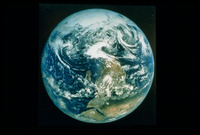| dc.description | "The overall objective of the mission was to demonstrate command and service module performance in a cislunar (between the Earth and Moon) and lunar-orbit environment, to evaluate crew performance in a lunar-orbit mission, to demonstrate communications and tracking at lunar distances, and to return high-resolution photography of proposed Apollo landing areas and other locations of scientific interest.
Mission Plan
The Apollo 8 mission was the eighth in a series of flights using Apollo-specification hardware, the second manned flight of a block II spacecraft, and the first manned flight using a Saturn launch vehicle. The mission was also the first to the vicinity of the Moon and was the continuation of a program to develop manned lunar landing capability.
The Apollo 8 mission took 7 days and included 10 orbits around the Moon. Almost without exception, spacecraft systems operated as intended. All temperatures varied in a predictable manner within acceptable limits, and consumables usage was always maintained at safe levels. Communications quality was exceptionally good, and live television was transmitted on six occasions. The crew superbly performed the planned mission.
Principal photographic objectives were to obtain vertical and oblique overlapping photographs during at least two revolutions, photographs of specific targets of opportunity, and photographs of a potential landing site through the spacecraft sextant.
Approximately 90% of the photographic objectives of the mission were accomplished. Approximately 60% of the additional lunar photographs requested as targets of opportunity were also taken despite early curtailment of crew photographic activities. Many smaller lunar features, previously undiscovered, were photographed. These features are located principally on the farside of the Moon in areas that had been photographed only at much greater distances by automated spacecraft. During the mission, seven 70-millimeter film magazines were exposed and yielded more than 150 photographs of the Earth and more than 700 photographs of the Moon. Five 16-millimeter color magazines were also exposed." -- From http://www.lpi.usra.edu/expmoon/Apollo8/A08_Photography.html#PHOTOS (accessed 11/5/03) | en_US |


